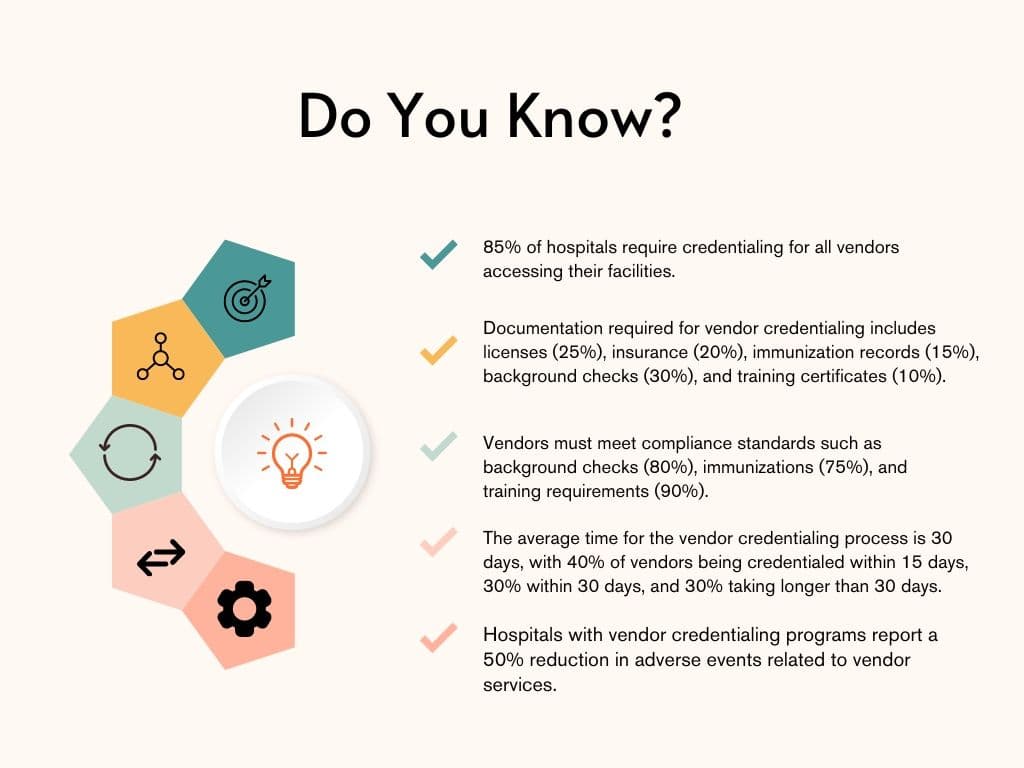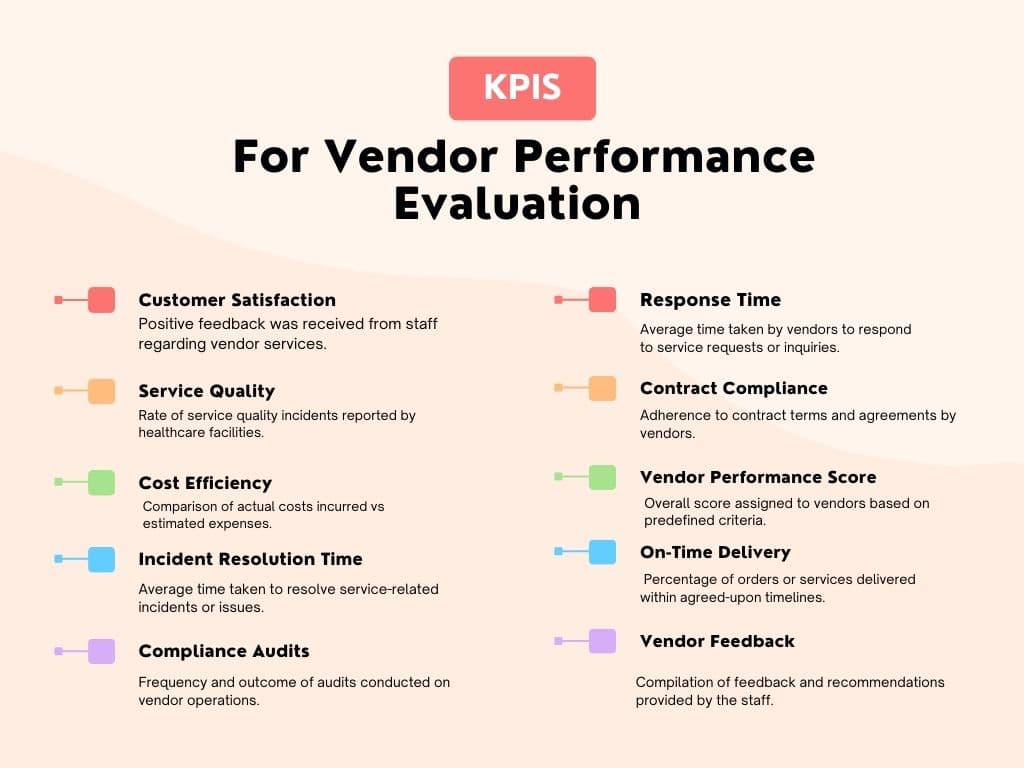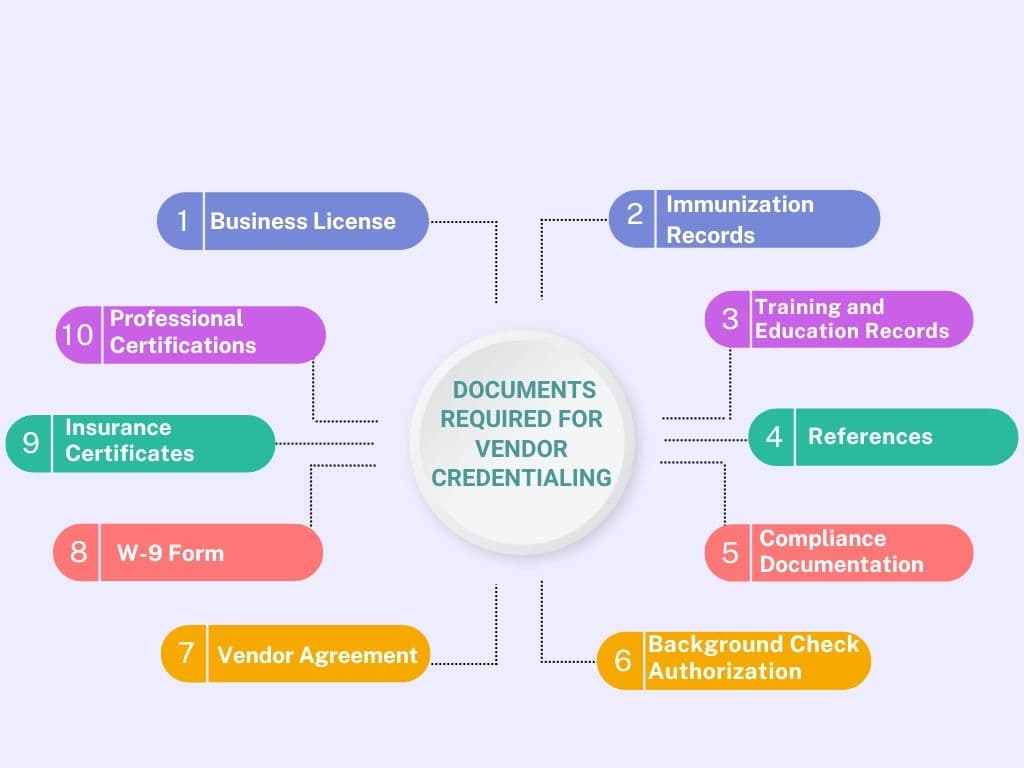Hospitals and doctors are the caretakers of the patients. Any disease or health problem faced by the people can be treated here and they get a lifetime cure. In order to maintain quality health service, health practices make sure to examine each process and supply used during the treatment. One of these verification procedures includes vendor credentialing.
Vendor credentialing is a type of quality checkup process of health supplies deemed by the hospital before buying process.
This procedure maintains the safety of patients and the hospital’s reputation by ensuring high-quality supplies.
If this term seems new to you or if you have a keen interest in knowing what credentialing is, we have compiled our detailed guide that will tell you everything about vendor credentialing, along with its benefits and importance.
An Overview Of Vendor Credentialing
It is the process of vetting third-party supplies, before getting their services and items. It ensures the quality standard in the health service while keeping all your services under rules and laws.
Vendor credentialing is administered by staff working in the supply chain department of the organization. Mostly, directors of the department conduct these procedures.
It is a common screening procedure performed by hospitals to make their services comply with legal and insurance policies. This helps in making the patient’s life improved by using updated and legally approved supplies.
Credentialing also involves using all available resources during the procedure.
I.e. you can get help from government resources that have already identified preapproved and authentic vendors along with blacklisted ones that you shouldn’t deal with.
Want to Know More About Credentialing? Click Now to Embark on Your Quest
Vendor De-Credentialing
Vendor de-credentialing is another crucial procedure that guarantees patient safety and upholds standards for high-quality service.
It is crucial to evaluate external vendors’ credentials and adherence to industry laws while working with healthcare institutions, such as medical equipment suppliers or service providers.
Unfortunately, there may be times when vendors routinely perform below average. They fail to match the facility’s specified criteria, which could be dangerous for the health of the patients.
De-credentialing becomes necessary in certain circumstances.
A comprehensive analysis of the vendor’s performance and compliance history is part of the de-credentialing procedure.
Vendor credentials may be canceled if they are discovered to be non-compliant or fall short of the facility’s criteria. De-credentialing vendors that fail to live up to the standards set by the facility safeguard patients from potential danger.
Additionally, it reflects the hospital’s dedication to giving its patients secure, first-rate care.
Vendor Termination
Another crucial step in managing vendor relationships is vendor termination. When a healthcare facility chooses to formally terminate its partnership with a vendor, termination takes place.
Termination may occur for several reasons, including persistent performance issues, contract violations, moral dilemmas, or rule-breaking.
Healthcare facilities carry out a thorough analysis of the problems behind the termination before ending a vendor relationship.
This evaluation may include discussions with the vendor, a careful analysis of performance information, and a look at any possible contractual violations.
In order to protect patient safety and keep the hospital’s reputation for providing high-quality care, vendor termination is crucial.
Healthcare facilities put patients’ needs first by keeping vendors responsible for their actions and performance.
What Role Does it Play For Hospitals?

Hospital vendor credentialing is a crucial step before providing any health service. Since it is directly going to affect your patient’s health and life it is important to pick a reputable vendor.
As a reliable one provides standard quality supplies. While a delisted one may provide poor quality supplies that may result in patient health decline, as a result, you may face legal consequences.
Not only for patients but vetting vendors is also important for regulation compliance. As any violation may cost hospitals to pay up to millions of fines per year.
Besides, rule violation will also result in a loss of patient trust, which in turn will weaken your health practice’s credibility.
It is also essential to note that you must consider only those vendors that come under an insurance payer coverage plan. Because insurance companies have strict rules, which you have to follow otherwise could lead to strict penalties.
With all this importance, hospitals must conduct vendor credentialing sensibly, if they want their services to comply with legal and quality standards.
Difference Between Vendor Credentialing And Facility Accreditation
Many healthcare facilities misinterpret vendor credentialing with facility certification. But actually they are two separate procedures.
Vendor credentialing entails assessing and confirming the credentials of outside suppliers of goods and services to healthcare facilities. The main objective is to make sure that vendors satisfy certain requirements.
They are made sure to follow industry rules, enhancing patient safety and maintaining the facility’s high standards of quality.
Contrarily, facility accreditation is a more thorough assessment of the healthcare facility as a whole, carried out by independent organizations.
The facility’s overall performance and compliance with industry best practices, such as the standard of patient care, safety procedures, personnel credentials, and infection control measures, are evaluated as part of accreditation.
Are You a Medicare Provider?
Accreditation of the facility is used as an independent indicator of its commitment to providing top-notch care. Facility accreditation centers on analyzing the internal operations and performance of the healthcare facility.
While vendor credentialing evaluates external vendors.
Both procedures are crucial for guaranteeing patient security, high-quality medical treatment, and industry compliance.
Benefits Of Credentialing
Where credentialing of supplies bought by the hospitals is an important part of the health service, it offers its benefits as well. There are many regulators that you must follow in your health service.
So the vendor credentialing process conducted by administrators meets them all at a time. Typically the joint commission, the ACS, DNV, COA, and the NCQA are the ones that introduce its rules.
Credentialing before buying supplies from any third party helps make sure your health services are all standard quality. It also helps your patients in getting recovered quickly and trust you regarding their wellness.
However, many hospitals go for credentialing software and organizations if they are unable to perform the process in-house.
Softwares and firms provide an entire credentialing service, from the vetting and approval stage to the ongoing standard verification.
Following are the main types of healthcare vendors that require credentialing:
| Vendor Type | Examples | Special Considerations |
| Medical Equipment Suppliers | MRI machines, surgical instruments | Ensure safety standards and regulatory compliance |
| Pharmaceutical Companies | Medication, vaccines | Check for FDA approval and storage requirements |
| Service Providers | Cleaning services, IT support | Verify licensing and background checks |
| Food and Nutrition Suppliers | Hospital food services | Compliance with health and safety regulations |
| Maintenance and Repair Vendors | HVAC maintenance, electrical repairs | Certifications and insurance coverage |
Information Required From Vendors During the Process
Health practices vary according to their facility capacity and operation areas. So each health institute demands different requirements from the vendors. In general, vendors are commonly required to have:
- A solid proof of the authenticity of the name and taxpayer information provided by the vendor representative
- Immunization proof of common diseases, especially measles, mumps, hepatitis, and flu
- The authenticity of CPR and other certificates
- Original documents of specific training and education fitting in federal and government policies
- Clear criminal background
- Screening of drugs
- Liability insurance proof
- Basic knowledge and compliance assurance of hospitals policies
- Complete verification that the vendor company is excluded in vendor firm lists maintained by the Health and Human Services’ Office of the Inspector. This list contains those vendors that have been found guilty in the past, the reason may be anything from potential fraud to license suspensions.
Process Of Vendor Credentialing

As credentialing is a crucial process for health practices, many of them move towards companies that conduct credentialing in a responsible way. The process is completed in 6 steps:
Choose A Company
First, you have to choose an adequate credential verification organization (CVO). The company must meet your health facility’s needs.
Setup Access Point
After when a CVO is employed, set up access points in your facility’s systems where your staff can access vendor information online.
These access points will also act as a front door as vendors who want to check in will access your facility through these points.
Analyze Vendor Info
When any vendor reaches you through the access point, make sure they have submitted their accurate information to the CVO database.
Some of the vendors don’t know about information submission, so guide them through the process.
After receiving their details, ensure the authenticity of their certificates, training, and vaccines. You must also carefully observe that their training fulfills your facility criteria and meets all your health practice needs.
Approval Stage
If a vendor satisfies your demands, approve them as a credible vendor within the CVO system.
Provide A Badge
When a vendor is approved, he will visit your health facility.
Verify their identity by checking their information in the CVO portal. After that, you have to provide them with a temporary badge to give access to the approved areas within your facility.
Monitor
As credentialing is an ongoing process, you must track the vendor’s performance over time. You don’t need to do it yourself as your CVO will have all the information about their activities.
Any problem that arises either due to a lack of efficiency or either any issue with the vendor’s certification, will be notified by the CVO.
The Role of Technology in Streamlining Vendor Credentialing

Modern healthcare cannot function without technology. Science has transformed many facets of the sector to increase effectiveness and improve patient care.
Let’s examine how technology helps healthcare facilities and vendors equally by facilitating vendor certification.
Digital Credentialing Platforms
The old paper-based credentialing procedures took a long time and were prone to mistakes. Digital credentialing platforms have made the entire process more simplified.
These platforms enable vendors to online submit their credentials, doing away with the requirement for paper documents. A centralized online system allows healthcare organizations to assess and confirm vendor certifications.
It saves time and money.
Automated Verification
In the past, credentialing required manually confirming the qualifications of vendors, which might be a time-consuming operation. Automated verification is now possible thanks to technology.
It allows the system to cross-check vendor data against databases and outside sources. This automation makes sure that vendors quickly and properly adhere to industry laws and meet particular criteria.
Real-Time Updates
Real-time updates and notifications are made possible by technology throughout the credentialing process. If any adjustments or upgrades are necessary, healthcare facilities and vendors can get immediate alerts.
This improves compliance and patient safety by ensuring that vendor credentials are always up to date.
Secure Data Management
Healthcare places the highest priority on data security. Credentialing platforms use strong security measures to safeguard private vendor data. These platforms also guarantee privacy laws are followed.
Vendors can trust that their data is secure. Hospitals can access the required credentials without jeopardizing the security of the data.
Streamlined Communication
Technology makes it possible for healthcare facilities and suppliers to communicate easily. The credentialing platform allows for the sharing of any questions, information updates, or explanations.
It improves communication and cooperation among those participating in the credentialing process.
Click Here to See Insider’s Guide On:
Performance Tracking
Healthcare institutions may more efficiently track and evaluate vendor performance due to modern technology.
Monitoring performance indicators, such as customer satisfaction and vendor response times, may guarantee that vendors continually provide high-quality products or services.
Facilities are now able to make well-informed vendor relationship decisions thanks to this data-driven strategy.
Compliance Monitoring
In order to make sure that suppliers continue to meet industry requirements over time, compliance monitoring is crucial for vendor certification.
Healthcare facilities use technology to carry out routine compliance audits and performance reviews.
Hospitals and clinics can ensure patient safety and high-quality care by closely monitoring compliance, quickly identifying any deviations, and taking the necessary corrective action.
Data Analytics and Continuous Improvement
Healthcare facilities can spot trends and patterns by utilizing data analytics. Facilities can apply continuous improvement techniques in their vendor credentialing procedures with the support of this data-driven insight.
Better vendor selections and increased overall efficiency result from ongoing process improvement based on data analysis.
Summing up all of this, here is an impact that credentialing put on hospital operations:
| Area of Impact | Positive Effects | Negative Effects |
| Patient Safety | Improved quality and reliability of supplies | Potential delays in procuring supplies if vendors are not credentialed timely |
| Financial Management | Reduced risk of financial fraud and billing errors | Initial cost and resource allocation for credentialing process |
| Compliance and Legal Risk | Better compliance with regulations | Risk of non-compliance if credentialing is not thorough |
| Operational Efficiency | Streamlined procurement processes | Increased administrative workload if not automated |
| Vendor Relationships | Stronger, more reliable vendor partnerships | Potential strain on relationships during rigorous credentialing |
How Credentialing is conducted in Telemedicine and Remote Services?
To support the novel approach to patient care, credentials in telemedicine and remote services have been modified.
Healthcare professionals can now complete the credentialing process online because of the prevalence of virtual credentialing and verification procedures.
Healthcare professionals now routinely submit their licenses, certifications, and other required documents electronically via remote document submission.
To examine providers’ qualifications in virtual contexts, video interviews, and tests are used.
The credentialing process takes into account telemedicine-specific requirements, such as proficiency in telehealth technologies and adherence to telemedicine rules.
To deliver care to patients in several regions, cross-state telemedicine credentialing also includes traversing many licensing and prerequisite systems.
In the changing environment of contemporary healthcare, these modifications to the credentialing procedure in telemedicine and remote services assure safe and efficient healthcare delivery.
The Future of Vendor Credentialing

By assessing the credentials of external suppliers and their compliance with industry rules, vendor credentialing has played a crucial role in the healthcare sector, assuring patient safety and high-quality care.
A number of intriguing advancements are expected to influence how credentialing is carried out as we look to the future.
1. Advanced Technology Integration
Vendor credentialing is anticipated to adopt cutting-edge technologies in the upcoming years for a more simplified process.
Artificial intelligence and automated technologies can help in real-time compliance assessment, background checks, and vendor credential verification.
These technological developments will speed up the credentialing process, decrease manual errors, and increase accuracy in general.
2. Blockchain for Enhanced Security
The approach to data protection and privacy taken by vendor credentialing could be changed by blockchain technology. Using a decentralized, immutable ledger, healthcare organizations can distribute and securely keep credentials.
Vendor data is assumed to be impenetrable with the usage of this technology. It will help protect crucial data and provide limited access.
3. Credentialing Portals
Dedicated vendor credentialing portals provide a centralized platform for vendors to submit and renew their credentials. They are anticipated to become more common.
These portals are accessible by healthcare facilities to check vendor qualifications, monitor compliance status, and maintain seamless vendor communication.
The facilities and vendors will be able to communicate and work together more effectively thanks to this simplified strategy.
4. Predictive Analytics for Risk Assessment
Predictive analytics may be used in the future to proactively assess vendor risk. Facilities can identify potential risk causes and take preventive action by analyzing historical performance data.
Healthcare facilities will be able to choose vendors with a track record of compliance and dependability thanks to this data-driven strategy, which will also assist them make educated decisions.
5. Continuous Monitoring and Compliance Updates
The process of ensuring vendor compliance is always changing. In the future, ongoing monitoring will be taken for granted.
Systems for updating compliance status, receiving real-time notifications for any violations of standards, and routinely evaluating vendor performance may be implemented in healthcare institutions.
The vendors will be continually kept in compliance with rules and with their credentials due to proactive monitoring.
6. Global Vendor Credentialing Standards
There will be an increased need for international vendor credentialing standards as the healthcare sector becomes more integrated.
In order to ensure uniform quality and safety medical billing and treatment around the world, it is necessary to establish global standards for vendor certifications and compliance.
7. Collaboration with Regulatory Bodies
To enhance credentialing procedures, hospitals may establish greater partnerships with regulatory agencies and industry organizations.
Working together, facilities may advance standardized credentialing processes, discuss best practices, and stay current on the most recent requirements.
Build a Stellar Reputation
Now that you have read the importance and role of vendor credentialing in building a health facility’s reputation, it is time to execute the process yourself.
If your facility is unable to perform credentialing in-house, get help from credentialing organizations. Remember to conduct the process in a careful way, as your patient’s life depends on the supplies you will buy from a certain vendor.

